| Paver & Hardscape Design |
.
| Paver Design and Installation Landscape pavers are a great choice for a hardscape material for a number of reasons. Landscape pavers are designed to be a fluid hardscape system.Landscape pavers are extremely durable and able to disperse weight better than concrete or mortared stone. So under extreme weight a landscape paver will distribute the weight to its gravel base rather than crack. If a paver does crack or is damaged, only the single paver must be replaces as opposed to the entire hardscape. In situations where tree roots and soil shifting would crack conventional concrete or mortared stone work, landscape pavers will simply move with the soil. It is also easier to repair this damage than with concrete or mortared stone. Instead of replacing the entire cracked area, landscape pavers are removed, the damaged base is adjusted and the pavers are then placed back onto the repaired base. There is no need to purchase new pavers. |
| | .....Hardscape Design We designs many different types of Hardscape. The following summary details some of our offerings and explains the benefit of landscape construction. Definition is sometimes clearer or easier when describing what something is not rather than what it is. Landscape construction or hardscapes, as some refer to it, is everything in the landscape that is NOT planting. It is not alive. It does not grow. With minor exception it does not change its form after the job's completion. What you see is usually what you get - as opposed to the diversely fluid life span of the planted garden. Landscape construction certainly defines outdoor space in the same way that planting beautifies outdoor space. Successful construction design and implementation has the ability to delineate space in a way that brings continuity and flow between the house and garden. It fortifies the functionality of the garden, pulling the user out as a participant rather than a mere observer. Its results are usually very immediate and in most cases permanent. It allows landscape to become architecture. .... .................... | .... | | ....... .........
| ...... |
| An interlocking paver system is comprised of several components. First, is the compact sub-grade, which is simply the existing compacted soil excavated to the appropriate elevation and followed by a layer of geotextile fabric. Second, is the compacted base material, which consists of compacted gravel ranging in a depth of about 4 to 6 inches depending on the application. Third, is a layer of bedding sand, which holds the pavers from below. Fourth, are the actual pavers. The entire perimeter is then surrounded by an edge restraint and joint sand is swept into the cracks. The entire area is compacted again to produce a hardscape that is far more durable than any asphalt, concrete or mortared stone hardscape. | | 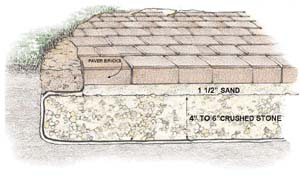 |
|
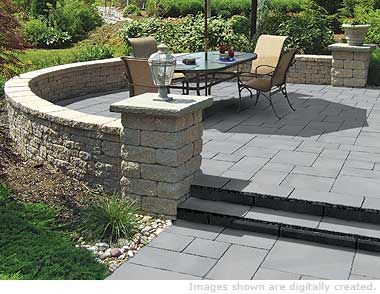
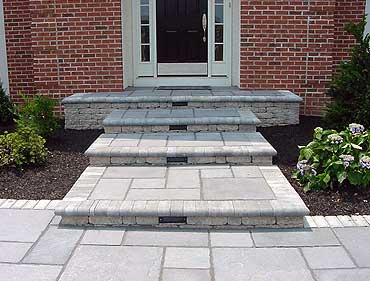
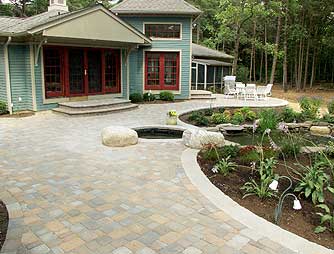

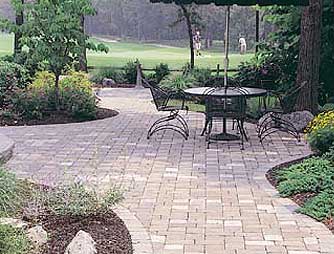
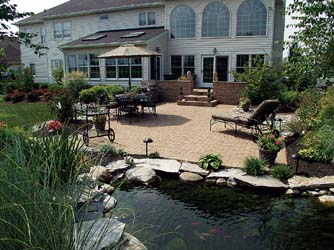
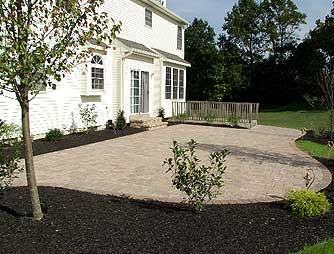
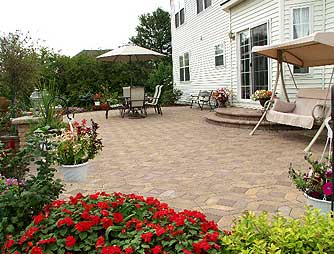
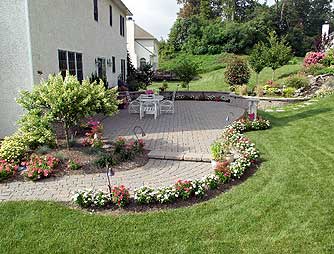
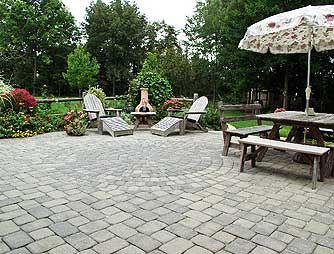
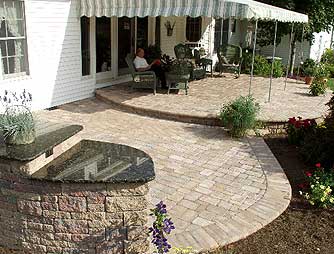
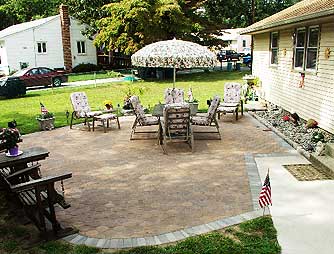
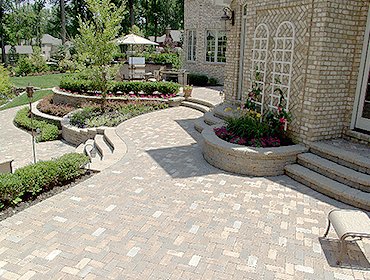
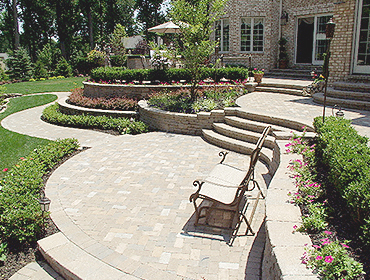
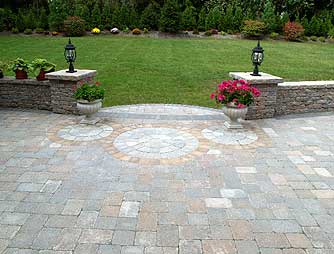
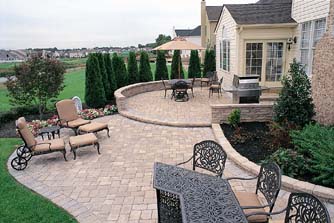
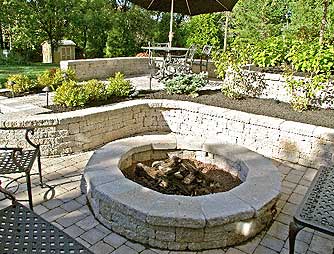
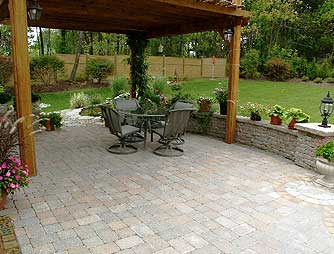
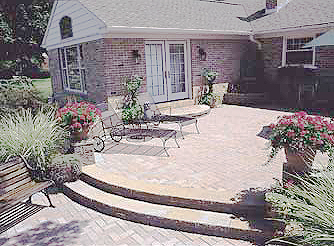
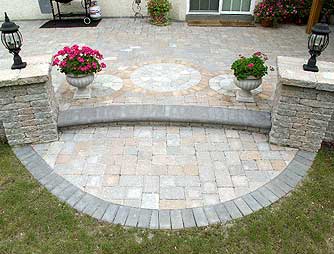
EP Henry and Rinox products
| | 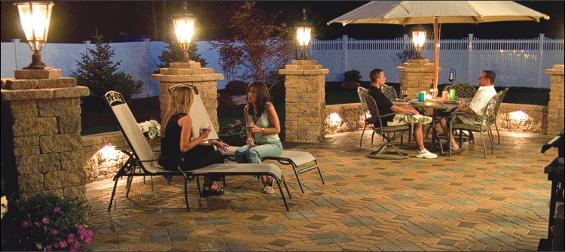 |
....... Frequently Asked Questions About EP Henry Back to top
| | Cleaning and Sealing How long do I need to wait before I clean and seal my pavers? As a rule of thumb we suggest waiting 3-6 months. This allows any efflorescence to come out and weather away naturally. If you have a lot of rainfall in the spring, 3 months should suffice. If your installation was done in June and we have a dry summer, you should probably wait at least 6 months. The real test is a visual inspection of the pavers: if efflorescence is not that heavy or noticeable you can proceed to clean and seal. What is Efflorescence? What does it cost to clean and seal my project? Depending on the amount of stains you have and the sealer you choose, the average cost would be less than $1.00 per square foot if you do it yourself. How do I choose a Sealer? Your choice of sealer depends on the look you wish to achieve. All sealers will inhibit stain penetrations; some will provide a high sheen or gloss while others will only enhance the color and provide little to no sheen. Cleaning & Sealing Product Information What tools do I need? For most residential jobs you will need a five gallon bucket, tape measure, magic marker, stiff handle nylon brush, roller and pan, garden hose and nozzle, protective eyewear, respirator and neoprene gloves. What are the advantages of sealing my pavers? Sealers offer three advantages: they help resist stains, enhance the color, and bind the sand in the joints to make it difficult for weeds to germinate. Sealers, however, are topical products and must be reapplied regularly (generally every 3-5 years). Only water-based sealers can be used in NJ and NYC. Cleaning & Sealing Product Information What can I do if my pavers are stained or damaged? One of the advantages of pavers is that individual units can be removed and replaced in these situations. Remove the sand around the paver and then use two flat head screwdrivers to lift the paver out. Rocking the paver gently in a back-and-forth motion will facilitate removal. Can I remove moss or mold from my pavers? Try Clorox liquid bleach diluted in water (10 parts water to one part Clorox). Be careful not to get it on other plant material. Keep in mind that there is nothing that will keep it from growing back if it's in a shady, damp area. For a more permanent solution, you will need to correct the moisture and shade problems that are encouraging the moss or mold. What is the whitish deposit I see on some paver installations? You are probably referring to efflorescence, a natural and common occurrence in many concrete and clay brick products. Efflorescence is the result of naturally occurring mineral salts found in the materials used in the production of pavers or block and EP Henry accepts no liability for its occurrence. When pavers become wet and absorb moisture the mineral salts are dissolved and are drawn to the surface of the paver with the moisture as it evaporates. This is not a product defect or harmful to the pavers and will usually weather away with time. While we recommend that you wait 6 months to a year for it to dissipate, if you don't want to wait for it to weather away, Techni-Seal offers an excellent cleaning product to remove it. Visit our Cleaners & Sealers page. Once the pavers are cleaned it is recommended that they be sealed. What is Efflorescence? How do I remove grease and oil stains from my pavers? To safely remove grease or oil stains from concrete pavers use a product specifically designed to do just that. An excellent product for this is Techni-Seal's Dirt and Grease Cleaner. It dissolves, dislodges, and encapsulates grease and oil so that it can be rinsed away. This is packaged in 2 quart containers and is available at most of our Authorized Hardscaping Centers. If you want to seal your pavers to help prevent future staining, we recommend sealers from Techni-Seal and SureBond. Before sealing your pavers you should do a general cleaning of the entire surface to remove any soils or surface efflorescence. Techni-Seal General Cleaner and Efflorescence Remover is a great product for this purpose. A word of caution: make sure that the pavers are completely dry before applying the sealer. You can find a distributor who handles these products by going to our Find-a-Distributor page. Also, to find more information about these products, go to: Paver Accessories. DevonStone™ Collection by EP Henry What are the advantages of DevonStone over natural stone? DevonStone is more uniform in thickness and in length and width dimensions, making installation faster and easier. Many natural stones also have inherent fractures, making them susceptible to cracking and spalling in freeze/thaw conditions. Back to top My DevonStone cast stone pavers have a white haze on them. What is it? It's probably efflorescence. This occurs when the natural salts in the raw materials (including sand, cement, and stone) are drawn to the surface by moisture. Efflorescence is common to all concrete products, is completely natural and will disappear with time. Cleaning & Sealing Product Information While efflorescence will eventually go away, there are cleaners available that are specifically formulated for concrete. Most of these contain acid and detergents, so be sure to follow all label directions and environmental regulations if you choose to use them. Remember. if you clean the DevonStone pavers, you must seal them. What is Efflorescence? I'd like my DevonStone pavement to have a sheen. Can I seal it? Yes, you can. Sealing will enhance colors and may prevent staining. If you choose to seal, do so a minimum of 60 to 90 days after completion of installation. Product should be cleaned prior to sealing. Can I put DevonStone on top of my existing concrete patio or walkway? Yes, you can, provided it's in good shape. Use a high strength, flexible concrete adhesive or a thin set bed (1/2" - 3/8") of mortar to adhere them to the concrete slab. All joints must be mortared (polymeric sand is not acceptable in these applications). Make sure you immediately clean any mortar residue off the pavers, using a damp cloth. How do I cut DevonStone? DevonStone can be easily cut with any power saw with a diamond blade. Always wear protective glasses and a mask when cutting with a power saw. If using water during the cutting process, be sure to immediately clean any residue that may be left on the stone, or staining will result. Do not use a hammer and chisel to cut DevonStone. Can I use DevonStone on my driveway? No. DevonStone is not suitable for any vehicular application. Can I use DevonStone inside? Absolutely, just install it the same way you would tile, with a thinset adhesive. Can I use DevonStone with my EP Henry pavers? You can, but you must account for the difference in thickness. Most pavers are 2 3/8" or 3 1/8" thick; DevonStone is 1 5/8" thick. Do not attempt to compensate for the variability in thickness with the bedding material. EP Henry Paver Why do EP Henry Pavers make the ideal pavement? Our pavers are the ideal product for freeze/thaw environments. Proper installation of the product results in a pavement that is rigid, yet flexible. The joints between pavers allow the walkway, driveway, patio, etc. to move without cracking. In addition, they can be "unzipped" to allow for repairs or access to utilities. Unlike asphalt, pavers are virtually maintenance-free. By definition, concrete pavers have a minimum compressive strength of 8,000 psi (about 3 times stronger than regular poured concrete) and a maximum water absorption rate of 5%. Why are they called interlocking concrete pavers? It is the system that makes them interlocking concrete pavers, not necessarily the shape. When installed properly, the combination of the pavers, bedding sand, edge restraint and joint sand causes them to interlock, allowing them to work as a unified, flexible pavement. Back to top Does the color go all the way through the paver? Most EP Henry Pavers (other than Coventry® and Bullnose) are manufactured with the Durafacing™ process which concentrates an extra dosage of cement and pigment on the wear layer. You'll never wear through this layer over the lifetime of the installation. Our non-Durafaced pavers have pigment throughout. How do I determine how much modified stone base material and sand I'll need? As a rule of thumb, use a minimum of 3”-5” of base material for walkways, 6”-8” for patios, and 8”-12” for driveways. The sand setting bed should be 1” thick. One ton of modified stone or sand will cover 100 square feet at 2” thick. Using a 10' x 10' (100 square feet) patio as an example, you would need 1/2 ton of sand for the setting bed (1” thick) and 3 tons of modified stone for the base (6” thick). You'll need some additional sand (about 5%) or two bags of EP Henry PolySand for the joints between the pavers. Someone recommended that I use a fabric under my installation. When and where is it used? EP Henry recommends a separation fabric (e.g., Mirafi® ‘s 500X) under all paver installations. The fabric is laid on top of the compacted soil in the excavated area and keeps the aggregate base material from working its way into the soil subgrade. This is especially important where the soil contains a lot of clay. At a cost of pennies per square foot, the separation fabric provides an insurance policy against base failure. Can EP Henry Pavers be used for my driveway? Absolutely! For residential driveways, 8” to 12”of compacted base material is recommended. A standard 2-3/8”thick paver can be used for light vehicular (cars and pickup trucks) applications. A herringbone pattern is most suitable in these situations. Typical Patterns (1.11 MB PDF) Tell me about the sand setting bed… The material for the bedding layer should be coarse concrete sand. Do not use stone dust or screenings; they do not allow the pavers to "seat" properly and do not allow for drainage. The sand should be an even 1” thick layer. Do not compact the sand setting bed. Do not mix portland cement into the sand used for the setting bed or the joints between pavers. It defeats the flexibility of the system, and it cannot be cleaned off the surface of the pavers. How do pavers compare with patterned or stamped concrete? Patterned concrete pavements are merely slabs of concrete that are embossed with a pattern. Therefore, they are prone to the same problems with freeze/thaw cycles, namely cracking and spalling. We GUARANTEE that EP Henry Pavers won't crack or spall; you cannot obtain a similar guarantee for stamped concrete. Stamped concrete requires expansion joints every 10 feet or so, which are very distracting in some patterns. Also, unlike EP Henry Pavers, patterned concrete pavements don't allow access to underground utilities or the ability to make repairs. At virtually the same price per square foot installed, EP Henry Pavers are clearly a superior choice. Back to top What are the advantages of sealing my pavers? Sealers offer three advantages: they help resist stains, enhance the color, and bind the sand in the joints to make it difficult for weeds to germinate. Sealers, however, are topical products and must be reapplied regularly (generally every 3-5 years). Only water-based sealers can be used in NJ and NYC. Cleaning & Sealing Product Information Will weeds grow between my pavers? Weeds and grass result from seeds or spores blowing into, and lodging in, the joint sand.This can be minimized by adding SandLock to your sand or by sealing the pavers or mixing a pre-emergent granular weed killer into the joint sand. If weeds do appear, a spot vegetation killer (such as Round-Up™) can be used and will not damage the pavers. What can I do if my pavers are stained or damaged? One of the advantages of pavers is that individual units can be removed and replaced in these situations. Remove the sand around the paver and then use two flat head screwdrivers to lift the paver out. Rocking the paver gently in a back-and-forth motion will facilitate removal. What can you tell me about snow removal and my pavers? Pavers can be plowed and shoveled just like asphalt or concrete pavements. In fact, the chamfered edges and joints around the pavers promote melting of snow and ice. A plow with a rubber edge is recommended. Do not use sharp objects to chop ice as they can damage the pavers. Both sodium chloride (rock salt) and calcium chloride will remove snow and ice but can harm the pavers (and any concrete surface for that matter). EnvironMelt is an effective and safe de-icer for your paving stone installation. I have an existing concrete walkway that's in pretty good shape. Can I lay pavers over it? While not the preferred method, pavers can be laid on top of existing concrete walkways. Two issues must be addressed. First, the grade will be raised by about 2 3/8" to 3" (the thickness of just the pavers or the pavers plus the bedding sand). This is particularly critical if any doorways are involved. Second, if the existing concrete slab should raise or drop with freeze/thaw conditions, then the pavers will do the same. Can I remove moss or mold from my pavers? Try Clorox liquid bleach diluted in water (10 parts water to one part Clorox). Be careful not to get it on other plant material. Keep in mind that there is nothing that will keep it from growing back if it's in a shady, damp area. For a more permanent solution, you will need to correct the moisture and shade problems that are encouraging the moss or mold. How about using EP Henry Pavers on my pool deck? Not only do EP Henry Pavers make an attractive pool deck, but they also provide a slip-resistant walking surface. Pavers actually are better than poured concrete around pools from the standpoint that the joints will take on moisture and leave the pavement cooler under foot. Like all products that are used outdoors, lighter colors will tend to stay cooler as they reflect the sunlight. Furthermore, our Bullnose Pavers make a nice pool coping. Make sure the base material around the pool is well compacted before installing pavers. Safety covers can also be installed over pavers with the use of special anchors. What type of sand should I have in between my pavers? The proper sand for sweeping into the joints between pavers is either mason's sand or coarse washed concrete sand. Both of these have a larger grain size than play sand, which will tend to blow or wash out. If you wish to stabilize the sand in the joints between your pavers to prevent washout and to thwart weeds and insects, use either EP Henry's Polysand or Techni-Seal's Polymeric Sand. Both of these are available at many of our distributors. If you are replacing existing joint sand with polymeric sand, you must carefully remove it to a depth that is 1"-1 1/2" from the surface of the pavers before reinstalling. Careful use of a pressure washer will achieve this; make sure you don't disturb the bedding sand. Without a sufficient amount of polymeric sand the cohesive strength needed to stabilize the sand joint will not be achieved. Make sure that you read and carefully follow all of the directions of the product before you start your project. My house was recently built, 5-7 years ago, should I expect my contractor to reinforce my homes foundation prior to my Hardscape installation due to continual settlement issues? Yes. If your house has been constructed within the past 7 years, there is a good chance that a 4' x 4' zone surrounding the homes foundation may add to continual settlement of the existing soils or a new Hardscape installation. The area can be reinforced in a number of ways, but must be addressed prior to Hardscape construction beginning. Please download our recommended engineering solution in PDF format. Back to top EP Henry Wall Systems What type of footing is required for EP Henry Wall Systems? A compacted stone base is required for all segmental retaining walls. This varies in thickness from a minimum of 4” for our Garden Walls to a minimum of 6” for our larger wall systems. Generally, the higher the wall, the thicker the base. You do not have to dig down below the frost line. How tall can I build my segmental retaining wall? Height limitations without Geogrid for all of our retaining wall products are listed within the catalog on the corresponding product pages. Designed and installed properly, segmental retaining walls can be built in excess of thirty feet high! Consult with a qualified contractor or engineer to see what may be required for your project. What do I use to adhere the caps on my retaining wall? Use a high strength, flexible concrete adhesive, such as Paver Bond, to affix your wall cap. What if I want to build a freestanding wall? No problem! EP Henry developed Double Sided Coventry® Wall to increase your creative options for walls that are functional and look great. Available in two heights and five lengths - like our original Coventry® Wall System - it’s perfect for wing walls, knee walls, sitting areas and more. When should I involve an engineer in the design of my wall? We recommend the use of a professional engineer on projects with taller walls (above 4’) or with unusual site conditions (steep slopes, parking lot or structure behind the wall). Local building codes may also necessitate the use of a professional engineer for walls above a certain height. We can provide design charts and tables with generalized engineering solutions for some of our retaining wall systems. Each situation is unique, however, and specific evaluation will provide the most accurate solution. What are tiered walls and how do I plan for them? Tiered walls are two or more walls placed in a multi-level arrangement. The second wall should be located behind the first wall at a distance of at least twice the height of the first wall under ideal soil conditions (e.g. if the front wall is 3’ high, the second wall should be at least 6’ behind it). See below for an example. Purchasing, Pricing and Installation of EP Henry Products Where can I find an EP Henry distributor? We have 100 distributors from New York to Virginia and each has displays of our products so you can see how they look firsthand. They can also help you with layout assistance, material calculations and other ancillary products and tools that you might need for a successful installation. To locate a distributor, go to our Find-a-Distributor page, input your zip code and the closest EP Henry Authorized Hardscaping Centers to you will be identified. I need pricing on EP Henry products, where can I get it? The final price of our products is determined by our independently owned Authorized Hardscaping Centers. Since they are independent businesses, prices may vary from one to the next. To locate a distributor, go to our Find-a-Distributor page, input your zip code and the closest EP Henry Authorized Hardscaping Centers to you will be identified. Can I purchase directly from EP Henry? EP Henry does not sell directly to the general public. We have 100 distributors from New York to Virginia and each has displays of our products so you can see how they look firsthand. They can also help you with layout assistance, material calculations and other ancillary products and tools that you might need for a successful installation. To locate a distributor, go to our Find-a-Distributor page, input your zip code and the closest EP Henry Authorized Hardscaping Centers to you will be identified. Does EP Henry provide product pricing or job estimates? EP Henry is exclusively a manufacturer of unit concrete products and as such does not provide pricing or job estimates. If you are a do-it-yourselfer looking for assistance, go to the Find-a-Distributor page, input your zip code and the closest EP Henry Authorized Hardscaping Centers to you will be identified. If you are looking to have your project professionally installed, go to our Find-a-Contractor page and follow the instructions to find the EP Henry Authorized Contractors in your area. Does EP Henry perform installations? EP Henry is exclusively a manufacturer of unit concrete products and as such does not install. The best way for you to get an accurate idea of the cost of doing your Hardscaping project is to get a qualified contractor to take a look at your specific job site. To find a contractor closest to you, go to our Find-a-Contractor page and follow the instructions. Our cover area; Philadelphia Pennsylvania and metro area, bucks, Delaware, Chester and Montgomery County PA as well as Lansdale, Montgomeryville, Lower Gwynedd, Blue bell, Horsham, Chalfont, Dresher, Warrington, Huntingdon valley, Willow Grove, Villanova, Ardmore, Bryn mawr, Yardley, new town square,Valley Forge, Broomall, Devon, Berwyn Click here for EP Henry Cleaning & Sealing Product Information |
| | Click here to get more information about Rinox products  |
portico pergola landscaping decks about us contact us back to home Back to top